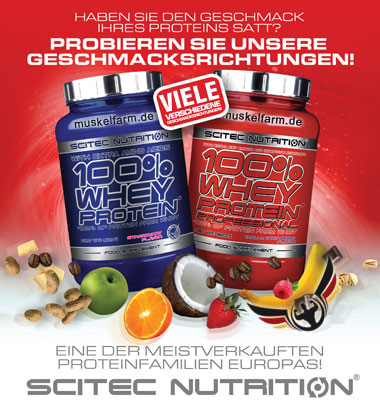Difference between Scitec Nutrition Whey Protein Professional (red) and normal 100% whey protein (blue)
 The Scitec 100% Whey Protein in the blue can and the Scitec Nutrition Professional Whey in the red can are absolutely high-quality protein supplements or protein shakes based on whey protein, which are enriched with a special amino acid matrix of L-leucine, L-glutamine and taurine for better effectiveness were. As a result, both supplements have been shown to help build and maintain impressive muscle mass. In addition, the regular intake of Scitec Nutrition 100 Whey Protein (blau) respectively Scitec Whey Protein Professional (rot) for example still have a positive effect on body tissue and bones. But even if both products have many parallels at their core, there are not only differences in terms of the ingredients or the mode of action that can be decisive for purchase.
The Scitec 100% Whey Protein in the blue can and the Scitec Nutrition Professional Whey in the red can are absolutely high-quality protein supplements or protein shakes based on whey protein, which are enriched with a special amino acid matrix of L-leucine, L-glutamine and taurine for better effectiveness were. As a result, both supplements have been shown to help build and maintain impressive muscle mass. In addition, the regular intake of Scitec Nutrition 100 Whey Protein (blau) respectively Scitec Whey Protein Professional (rot) for example still have a positive effect on body tissue and bones. But even if both products have many parallels at their core, there are not only differences in terms of the ingredients or the mode of action that can be decisive for purchase.
Parallels and differences between Scitec Whey and Professional
With regard to the pure protein content, the blue Scitec Whey and the red Scitec Professional Whey are absolutely equal. In contrast to the “normal” whey protein from Scitec, Scitec 100% Whey Protein Professional is a multi-component preparation that not only consists of whey concentrate but also contains whey isolate. This whey isolate is considered to be the purest whey protein (whey protein), especially since it is produced using particularly nutrient-friendly production processes. In addition, thanks to the special process, this isolate is almost free of fats and milk sugar or lactose. Hence points Scitec Professional Whey (rot) compared to Scitec Whey (blau) has a lower proportion of sugar and fat, which is why it is clearly to be preferred in the context of a low-carb diet, low-carbohydrate or generally low-calorie diets and during specific definition phases. In addition, due to its lower lactose content, Scitec Nutrition Professional Whey is recommended for all athletes who are somewhat sensitive to lactose (provided it is not a pronounced lactose intolerance).
Another important difference is that Scitec 100 Whey Professional (red) has been enriched with valuable enzymes. These enzymes support the body with digestion, among other things, which makes Scitec Professional Whey even more digestible than conventional whey protein. In addition, thanks to the enzymes, the body can better absorb and use proteins and amino acids. As a result, Scitec Nutrition 100% Whey Protein Professional can also be advised with regard to building and maintaining muscle mass, although the conventional whey protein (blue) from Scitec is also completely convincing in this regard and should therefore also be sufficient for recreational athletes with a normal digestion .

Finally, it should be noted that there are also differences in terms of taste. By that is meant that it is Scitec Nutrition Whey Protein At first only in so-called mono flavors, such as chocolate, vanilla or banana, whereas Scitec Professional Whey was also available in combination flavors, such as strawberry-white chocolate, chocolate-coconut, chocolate-hazelnut or vanilla-verry-berry (Forest fruit) was offered, but there have been adjustments in this regard in the meantime. Nevertheless, it is worth taking a look at the long lists of the respective flavors.
Conclusion Scitec Nutrition Whey Protein red or blue
Ultimately, all whey protein products from Scitec Nutrition can be recommended without hesitation. However, those who are slightly sensitive to lactose should tend to Scitec Professional Whey. The same goes for people who are looking for a whey protein supplement that is lower in fat and carbohydrates. Also speaks for Scitec 100% Whey Professionalthat, in contrast to normal whey protein, it has been enriched with enzymes, which makes it not only more digestible, but even more effective. In addition, the protein shakes differ in the flavors, which may be a reason for one or the other to prefer the whey protein in the blue or red can.





Hello,
I'm looking for a shake that goes with my diet. Someone recommended the Scitec Nutrition Whey Protein to me, but I am unsure because I read something with muscles everywhere. I do sport but not strength training, I want to lose weight and define my figure but not be muscle-packed :-). Can you help me?? Many thanks